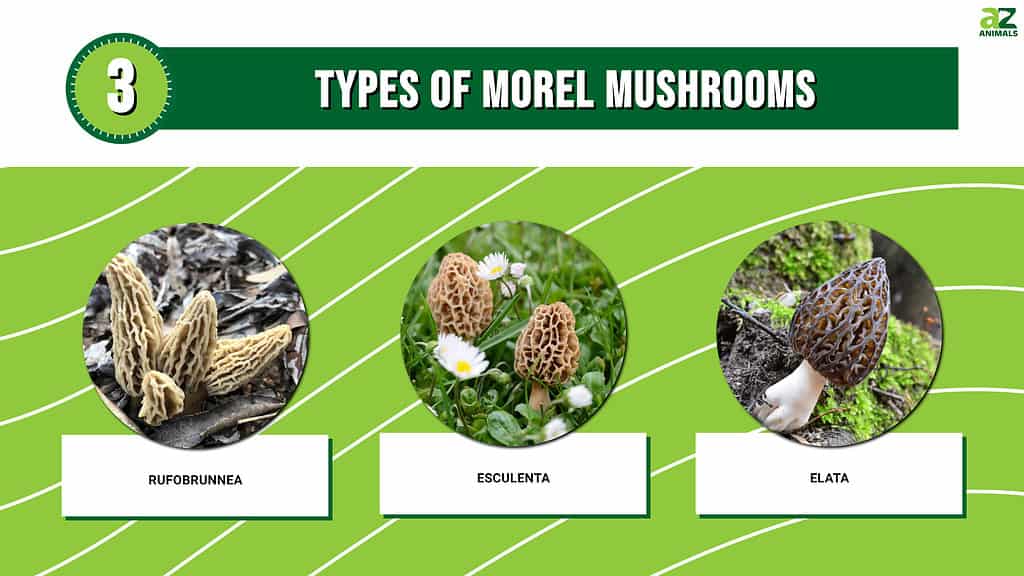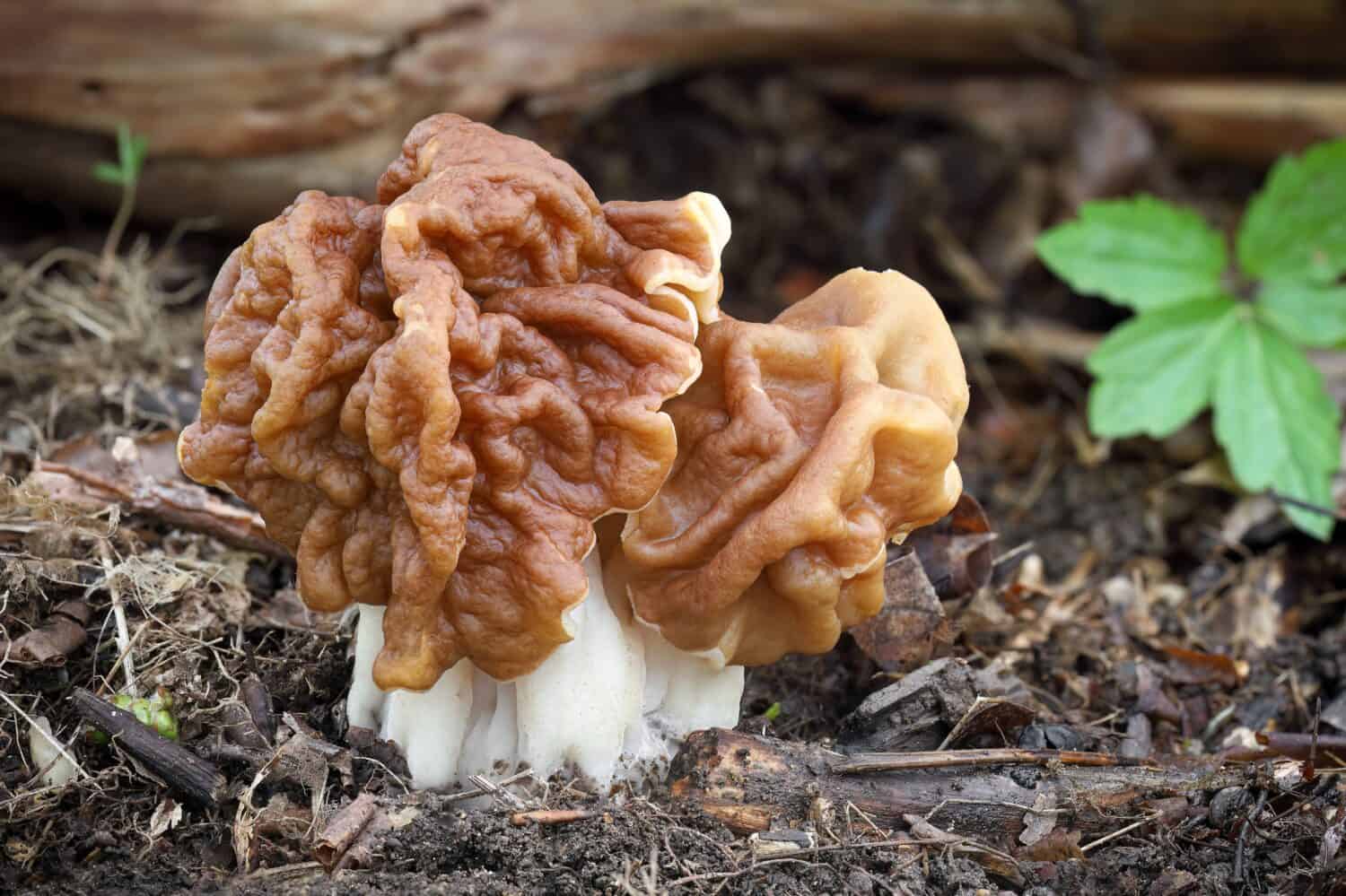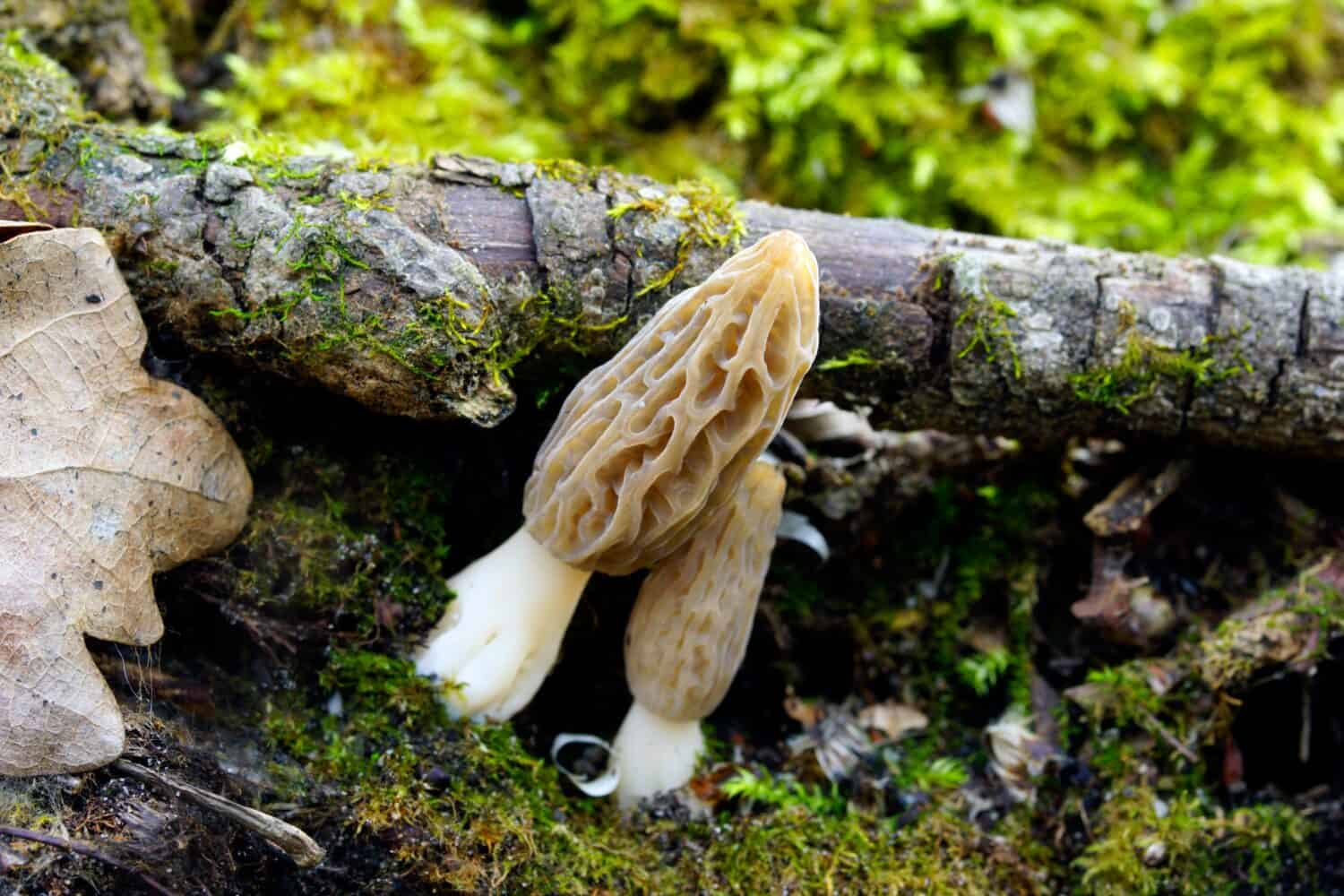Morel mushrooms, scientifically known as Morchella, are a fascinating group of edible fungi. Mushroom enthusiasts and gourmet cooks alike highly regard these incredible mushrooms. Their exact classification and species count are subject to ongoing research and debate. However, in this article, we will explore some widely accepted classifications for types of morel mushrooms.
The number of recognized morel mushroom species worldwide, and specifically in North America, can vary depending on the source and the latest scientific discoveries. However, there are approximately over 80 to 100 described species of morel mushrooms globally. There are over 20 recognized species in North America.
Morels belong to the Morchellaceae family. This family is divided into clades or lineages based on genetic similarities and morphological characteristics. The exact number of clades can vary depending on the classification system used by researchers. Furthermore, researchers established three recognized clades or groups of morel mushrooms. They are referred to as the Rufobrunnea clade (white morels or M. section Rufobrunnea), the Esculenta clade (yellow morels or M. section Morchella), and the Elata clade (black morels or M. section Distantes).
Each clade contains several distinct species of morel mushrooms, with variations in size, shape, color, and habitat preferences. Once again, it’s important to note that ongoing research and taxonomic revisions may change the number of recognized species and their classification in the future.

Yellow morels, or
Esculentaclade morels, grow primarily around areas with deciduous trees.
©milart/Shutterstock.com
The Three Types of Morel Mushrooms
As previously mentioned, researchers have classified morels into three types of morel mushrooms or clades.

Rufobrunnea Clade (White Morels or M. Section Rufobrunnea)
The Rufobrunnea clade consists of white morels. Characteristics of these morel mushrooms include their white to pale yellow caps. The caps have a distinctive honeycomb-like texture formed by pits and ridges.
You can typically find this clade in grassy areas, meadows, and open woodlands. They are prevalent to spot in the spring. They require moist soil and a temperate climate for optimal growth. Notably, Rufobrunnea clade morels are saprobic, meaning they derive nourishment from dead or decaying organic matter. Consequently, their growth isn’t dependent on a particular tree species. Therefore, it occurs independently of trees.
You can primarily find the Rufobrunnea clade distributed across western North America, the Mediterranean Basin, and Australia. One of two species of this clade, Mochella anatolica, has only been found in the Mediterranean basin.
Esculenta Clade (Yellow Morels or M. Section Morchella)
The Esculenta clade comprises yellow morels. Characteristics of these morel mushrooms include their yellow to yellowish-brown caps. Like other morels, they have a honeycomb-like texture formed by pits and ridges. The honeycomb pattern of these morels is random and not vertical like Elata clade morels.
You can commonly find the Esculenta clade in woodlands, forests, and areas with deciduous trees in particular. Like with all morels, the exact timing of growth varies depending on the local climate and weather conditions. These morels are associated with the awakening of deciduous trees in the forest and depend on trees as their host.
You can find Esculenta clade morels in various parts of the world, including North America, Europe, and Asia. They are particularly common in regions of the United States and Canada.
Elata Clade (Black Morels or M. Section Distantes)
The Elata clade encompasses black morels. These morels have dark brown to blackish caps. Similar to other morels, they possess a honeycomb-like texture formed by pits and ridges. The cap tends to be longer than the stem, while the stem tends to be lighter than the cap. Moreover, the stem tends to be a sandy yellow or whitish color.
Similar to Esculenta clade morels, you can typically find these morels in woodlands and forests, particularly in areas with coniferous trees. Like the other two clades, this clad is abundant during spring, thriving in moist soil and moderate climatic conditions.
Elata clade morels have a wide distribution, similar to the Esculenta clade morels. They inhabit various parts of the world, including North America, Europe, and Asia.
Finally, the coloration of all morels tends to indicate how strong the flavor is. Elata clade morels tend to be more nutty, earthy, and even smokey compared to the other two clades. This makes them a popular morel variety for various cuisines due to their distinct taste.

Black morels, or
Elataclade, prefer to grow around areas with coniferous trees.
©AleksandarMilutinovic/Shutterstock.com
What Is the Difference Between the True Morel vs. the False Morel?
True morel mushrooms and false morel mushrooms are two distinct groups of fungi that differ in terms of their morphology, edibility, and potential toxicity. Understanding the differences between these two groups is crucial for foragers and mushroom enthusiasts to ensure their safety.
True Morel Mushrooms
People highly regard true morel mushrooms, which belong to the Morchella genus, for their distinctive appearance and culinary value. They include the three types of morel mushrooms, or clades, previously mentioned.
The characteristics of these morel mushrooms consist of cone-shaped or elongated fruiting bodies, which feature a cap with a wrinkled or pitted surface resembling a honeycomb. True morels have a hollow and interconnected interior within the cap. People prize these mushrooms for their rich flavor, making them popular in gourmet cuisine.
False Morel Mushrooms
False morel mushrooms, on the other hand, are from various genera, including primarily from the Gyromitra genus but also from the Verpa genus and even others. Unlike the true morels, false morels have caps that are irregularly convoluted or brain-like in shape, lacking the characteristic honeycomb structure. Instead of a hollow interior, false morels contain cotton-like or solid tissue.
Additionally, their caps are often fused to the stem at the top, while true morels have a free-hanging cap.
Toxicity
One critical difference between true and false morel mushrooms is their toxicity. False morels contain a compound called gyromitrin, which converts into a toxic chemical called monomethylhydrazine (MMH) during digestion.
MMH can cause severe poisoning symptoms, including nausea, vomiting, abdominal pain, dizziness, and in severe cases, liver damage. It is important to note that cooking false morels does not eliminate the toxin, and consumption is strongly discouraged.
Edibility
When correctly identified and prepared, true morel mushrooms are edible and safe for consumption. However, it is crucial to properly cook them before eating, as raw or undercooked morels can cause digestive discomfort for some individuals.
In contrast, false morel mushrooms are inedible or even toxic due to their potential toxicity and the difficulty in effectively removing the toxins through cooking. Consuming false morels can lead to severe health issues and shouldn’t be used in cooking.
Remember, it is essential to exercise caution and rely on reliable field guides or expert identification when foraging for mushrooms, especially distinguishing between true morels and false morels, to ensure your safety and enjoyment of these unique fungi.

False morels can closely resemble true morels. However, one way to tell the difference is that false morels are not hollow like true morels.
©Jaroslav Machacek/Shutterstock.com
Morel Mushroom Anatomy
Cap
The cap of a morel mushroom is the uppermost part of the fruiting body. It is typically cone-shaped or elongated, resembling a honeycomb. The surface of the cap is wrinkled or pitted. It forms a pattern of ridges and depressions that gives the mushroom its distinctive appearance. The cap color can vary among species, ranging from pale yellow to tan, brown, or even black.
Pits and Ridges
The pits and ridges on the surface of the morel cap are notable features. The pits, also known as alveoli or ascomata, are the depressions or indentations on the cap. They are arranged in a distinctive pattern, resembling a honeycomb or sponge-like structure. The ridges, also called conical fronds, are the elevated areas that separate the pits, giving the cap its textured appearance.
Hollow Stem
The stem of a morel mushroom is typically hollow, which means it contains empty space inside. The stem emerges from the base of the cap and extends downwards into the ground. It is usually light in color, ranging from whitish to pale yellow or tan. The stem supports the cap and connects it to the mycelium, the fungal network beneath the soil.
Fertile Surface
The fertile surface of a morel mushroom is located on the inner side of the cap, within the pits. It is composed of microscopic structures called asci, which contain the spores. Morel mushrooms are part of the Ascomycota phylum, characterized by the production of spores in sac-like structures known as asci.
Size
Morel mushrooms vary in size depending on the species and environmental conditions. They can range from a few centimeters to several inches in height. The cap size can also vary, with larger morels reaching several inches in length and smaller ones measuring just a few centimeters.

There are well over 80 morel species worldwide.
©Rudenko Yevhen/Shutterstock.com
Lists of 45 Morel Species Found Worldwide Classified by Type
| Rufobrunnea clade (white morels or M. section Rufobrunnea) |
|---|
| Morchella anatolica |
| Morchella rufobrunnea |
| Elata clade (black morels or M. section Distantes) |
|---|
| Morchella angusticeps |
| Morchella arbutiphila |
| Morchella australiana |
| Morchella brunnea |
| Morchella conifericola |
| Morchella deliciosa |
| Morchella disparilis |
| Morchella dunalii |
| Morchella elata |
| Morchella eohespera |
| Morchella eximia |
| Morchella eximioides |
| Morchella exuberans |
| Morchella feekensis |
| Morchella iberica |
| Morchella importuna |
| Morchella kakiicolor |
| Morchella laurentiana |
| Morchella magnispora |
| Morchella mediteterraneensis |
| Morchella populiphila |
| Morchella pulchella |
| Morchella punctipes |
| Morchella purpurascens |
| Morchella semilibera |
| Morchella septentrionalis |
| Morchella sextelata |
| Morchella snyderi |
| Morchella tomentosa |
| Morchella tridentina |
| Esculenta clade (yellow morels or M. section Morchella) |
|---|
| Morchella americana |
| Morchella castaneae |
| Morchella diminutiva |
| Morchella dunensis |
| Morchella esculenta |
| Morchella fluvialis |
| Morchella galilaea |
| Morchella palazonii |
| Morchella prava |
| Morchella sceptriformis |
| Morchella steppicola |
| Morchella ulmaria |
| Morchella vulgaris |

Foraging for morel mushrooms can be a fun and fascinating adventure.
©Krista Parker/Shutterstock.com
Foraging for Types of Morel Mushrooms
There is a wide variety of places you can forage for morel mushrooms. Foraging for types of morel mushrooms is a thrilling endeavor that allows individuals to connect with nature while seeking out these prized delicacies. Understanding the habitat preferences, geographical regions, seasonality, and essential tips for successful foraging in each region can significantly enhance your chances of finding these elusive mushrooms. Remember to prioritize safety, respect local regulations and ecosystems, and consult reliable identification resources before consuming wild mushrooms.
Moreover, morels have a unique flavor and distinctive appearance, making them sought-after delicacies. You can apply the fundamentals of morel hunting to locations worldwide. However, let’s explore how, when, and where to forage for morel mushrooms in their commonly found areas in North America, Europe, and Asia.
Morel Mushroom Foraging in North America
North America has an abundant morel population from all three clades. Each clade offers ample opportunities for foraging enthusiasts. Here are some key aspects to consider.
Habitat
Depending on the clade, you can find morels in North America in association with coniferous and deciduous trees. Particular trees that host many different species of morels include larch, Douglas-fir, pine, ash, elm, tulip tree, sycamore, apple trees, and cottonwood. They thrive in areas with rich organic matter and moist soil.
Geographical Regions
Morels inhabit various regions in North America, including the Midwest (such as Michigan, Illinois, and Wisconsin), the Appalachian Mountains, the Pacific Northwest, and the Rocky Mountains.
Seasonality
Morel season in North America typically begins in early spring and extends into early summer. However, the exact timing can vary depending on the region and local climate. Factors such as temperature, rainfall, and soil moisture influence the emergence of morels. Autumn, before the first frost in higher elevations, can also facilitate a peek in morel growth.
Tips for Successful Foraging
To increase your chances of finding morels, explore forests with suitable tree species, pay attention to soil moisture, and search for areas that have experienced recent disturbances like wildfires or logging. According to the Government of Northwest Territories, morel hunting within burned forest areas is one of the best places to find an abundance of morels.
Morel Mushroom Foraging in Europe
Europe offers diverse habitats for morel mushrooms, providing exciting foraging opportunities. Consider the following information when foraging in Europe.
Habitat
Morels in Europe are commonly associated with coniferous and deciduous trees. Particular trees that host many different species of morels include fir, pine, poplar, ash, elm, chestnut, alder, strawberry trees, olive trees, beech, tulip tree, sycamore, apple trees, and cottonwood. They prefer well-drained soil, and you can often find them in woodland edges, clearings, and disturbed areas.
Geographical Regions
Morels reside in areas throughout Europe, with notable regions including France, Germany, Poland, Hungary, the United Kingdom, and Scandinavia. Specific species and timing may vary across these regions. It is also worth noting that you can find morels in the nearby Mediterranean Basin.
Seasonality
Morel season in Europe generally spans from late spring to early summer and even fall, factoring in elevation, weather, and aligning with the awakening of deciduous trees. Warmer temperatures and consistent rainfall create favorable conditions for morel mushroom growth.
Tips for Successful Foraging
Explore diverse woodland habitats, focus on areas with suitable tree species, and seek out areas with moist soil and favorable microclimates.
Morel Mushroom Foraging in Asia
Asia is home to a wide variety of morel mushrooms, providing an intriguing landscape for foragers. Here are some insights for foraging in Asian regions:
Habitat
Morels in Asia reside in diverse habitats, including mixed forests, deciduous forests, coniferous forests, and open woodlands. Common tree species you can find morel mushrooms near include pine, spruce, oak, birch, ash, elm, tulip tree, sycamore, apple trees, and cottonwood.
Geographical Regions
Notable regions for morel foraging in Asia include Turkey, China, India, Nepal, Bhutan, and the Himalayan foothills. Each region offers unique species diversity and foraging experiences.
Seasonality
Morel season in Asia varies across different regions and elevations. It generally occurs in spring and early summer. However, the timing can be influenced by local climate patterns and altitude, allowing abundant morel growth in autumn as well.
Tips for Successful Foraging
Research specific regions and their associated morel species, explore diverse forested areas, pay attention to elevation and microclimates, and consider local ecological factors that influence morel distribution.
Summary of The 3 Types of Morel Mushrooms
Here are the three different types of morel mushrooms:
| Rank | Mushrooms |
|---|---|
| 1 | Rufobrunnea Clade (White Morels or M. Section Rufobrunnea) |
| 2 | Esculenta Clade (Yellow Morels or M. Section Morchella) |
| 3 | Elata Clade (Black Morels or M. Section Distantes) |
The information presented on or through the Website is made available solely for general informational purposes. We do not warrant the accuracy, completeness, or usefulness of this information. Any reliance you place on such information is strictly at your own risk. We disclaim all liability and responsibility arising from any reliance placed on such materials by you or any other visitor to the Website, or by anyone who may be informed of any of its contents. None of the statements or claims on the Website should be taken as medical advice, health advice, or as confirmation that a plant, fungus, or other item is safe for consumption or will provide any health benefits. Anyone considering the health benefits of particular plant, fungus, or other item should first consult with a doctor or other medical professional. The statements made within this Website have not been evaluated by the Food and Drug Administration. These statements are not intended to diagnose, treat, cure or prevent any disease.
Thank you for reading! Have some feedback for us? Contact the AZ Animals editorial team.







